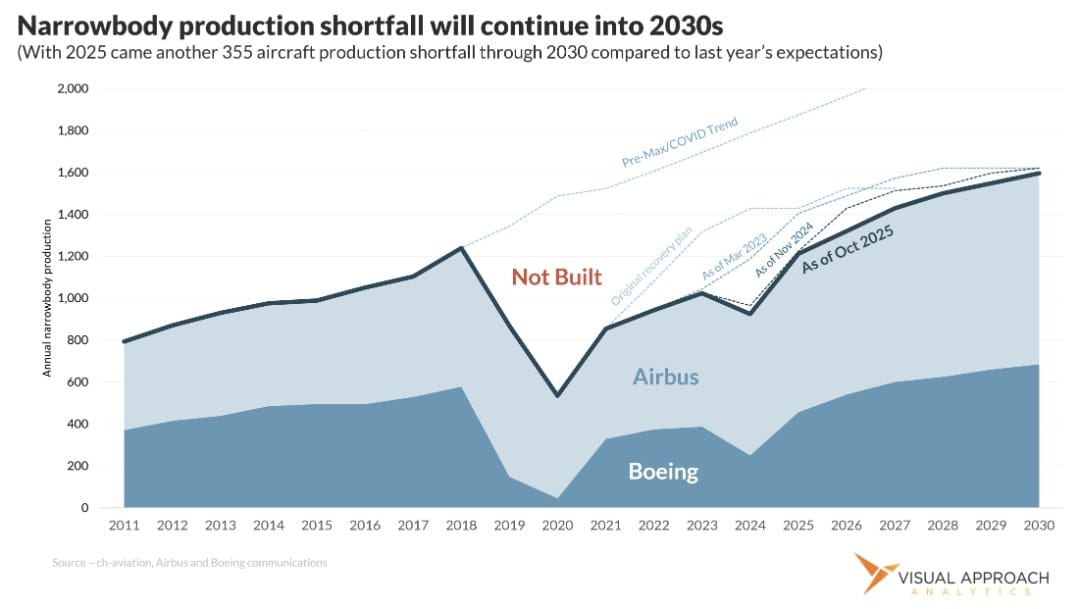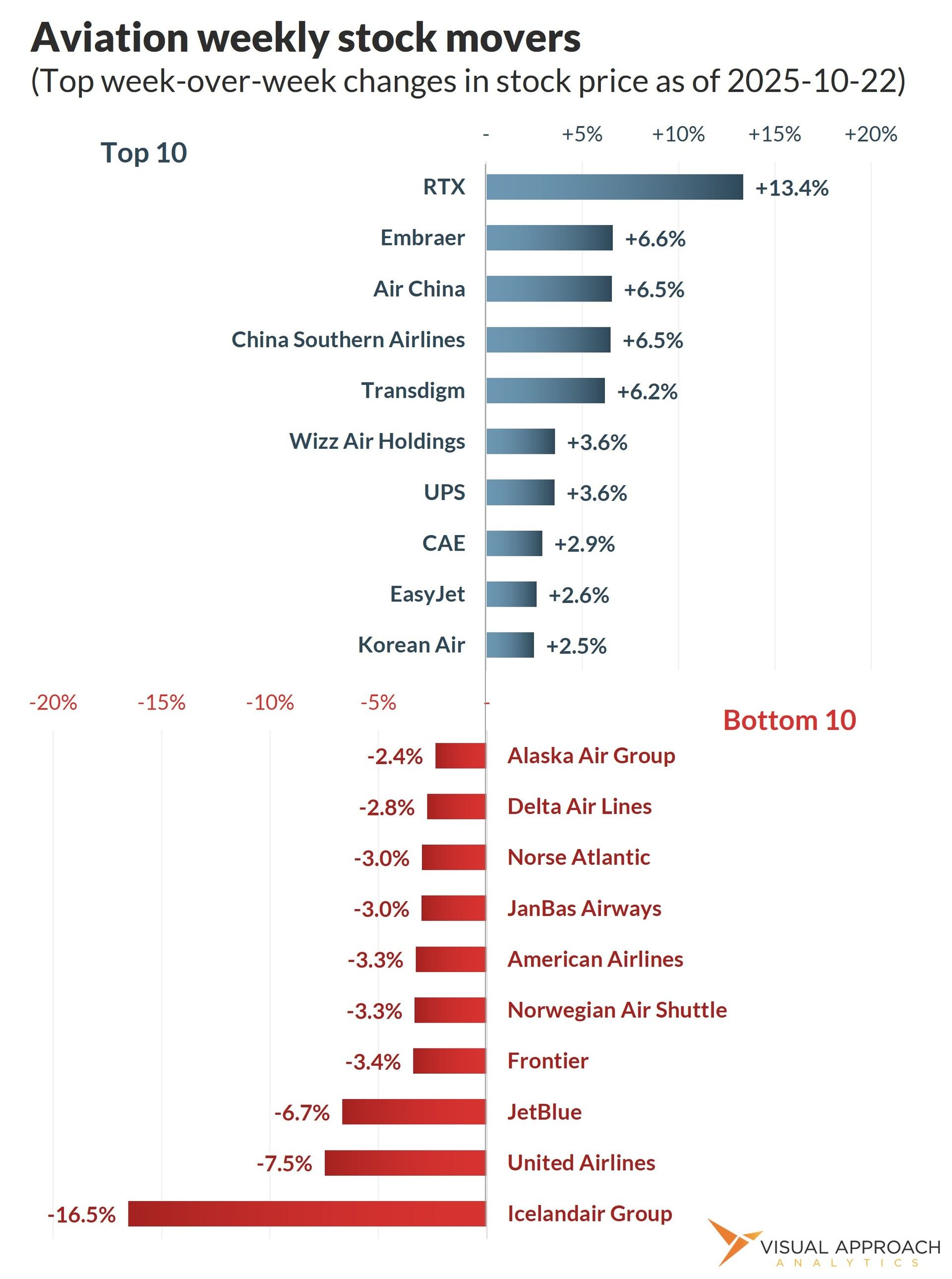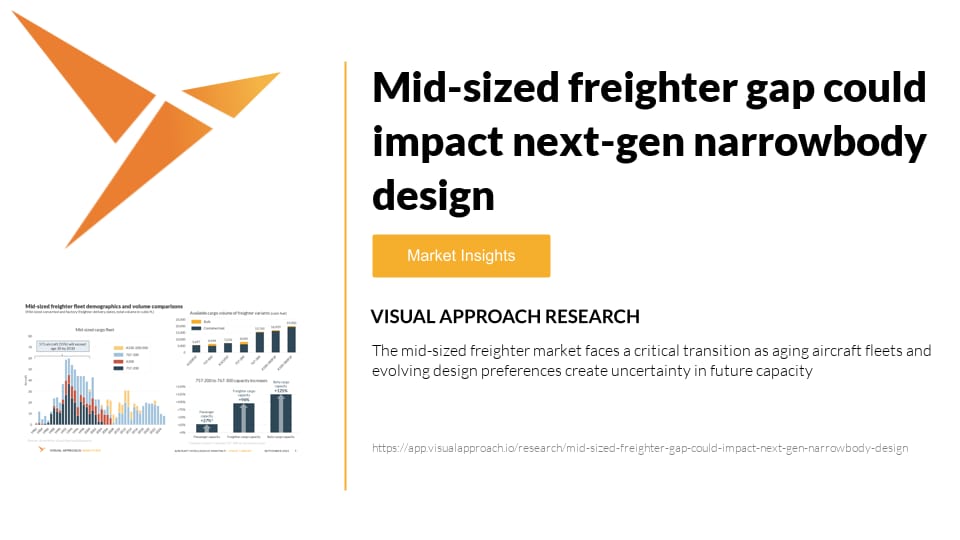- Aviation's Week in Charts
- Posts
- The narrowbody shortage won't last forever
The narrowbody shortage won't last forever
Entering year five of the narrowbody shortage, what happens next?

It’s been five years since we first noticed the looming aircraft shortage, and production still lags behind 2019 levels. How long can this shortage last?
Probably not much longer, but not for the reasons you may think. Here’s how we think the aircraft shortage plays out.
First, let’s recap: the sun rose on January 1st, 2019, with birds chirping, hangovers throbbing, and production lines humming. Airbus and Boeing were both printing profits, and the only news was of a teensy bit of corruption in the European offices. The lone stormy on the horizon was that of the Daniels variety. Spirit was turning 20%+ operating margins, and only 10 months prior, Doug Parker had said out loud what we were all clearly thinking: American Airlines will “never lose money again.”
In the next 14 months, the entire Boeing 737 MAX fleet would be grounded, a pangolin and a cat would (allegedly) give someone the sniffles, and air travel would drop by 97%. The demand for aircraft would be nil, and subsequently, the production of aircraft would plummet further.
To make a short story shorter, people would get shots, stop getting sick, and want to fly on airplanes again - just without enough aircraft being built. End result: an aircraft shortage.
Since the industry slowly came around to the idea of a shortage, it has reacted in predictable ways. Aircraft backlogs ballooned, seat gauges got larger, ticket prices skyrocketed, and operating costs exploded.
Oh, and there was something about powdered metal, a door that wasn’t supposed to be a door, and a strike.
Great. Now you’re caught up.
Throughout all of this drama over the past half-decade, an often overlooked factor is increasingly driving the narrative for the next half-decade: new technology engine maintenance costs are out of control.
With annual life-limited parts escalation in the double-digits, time on wing at half of prior technology engines, and shop visit costs delivering unpleasant surprises, the narrowbody shortage has rapidly turned into a shortage of available engines.
Old technology narrowbodies are enduring an extra shop visit to keep the predictable engines operating for longer. Retirement ages are increasing beyond 30 years.
And six-year-old A321neos are being parted out.
Welcome to the upside-down.
To answer the question of how the aircraft shortage concludes, the industry is focusing on what brought us into the shortage: production. As several industry colleagues have pointed out, we can’t build our way out of this shortage. Aircraft are 20+ year assets, meaning it will take nearly as long for that thin vintage to make its way through the system. What is a new aircraft shortage today will be a mid-life shortage in the future. Aircraft fit different roles at different ages.
But we don’t think production will end the shortage; we don’t even think it can. And yet the shortage will conclude.
For one, a downturn is coming. How do we know? Because 100% of all economic cycles have included a downturn. We don’t know when, but we know one will arrive, and it is very likely to be the impetus for the conclusion of the shortage.
But we’re also looking at the age-old trends in aviation that have been broken leading into that downturn. For instance, capacity is now defined by available engines, rather than available aircraft. Those engines are much more expensive to keep flying, so much so that the aircraft most in demand can be chopped up at only six years old to harvest the engines.
Airlines have been pouring operating costs into a supply-constrained market, meaning any drop in demand will slide below the more expensive supply more quickly. Traditionally, the older generations are first to be parked during a downturn, but this time, those are the more cash-efficient aircraft. Consider an airline looking to reduce capacity and is facing a $27 million full shop visit cost for a 737MAX (the “works” for two engines, including LLPs). That airline is also looking at a $22.5 million full shop visit cost for a 737-800. $4.5 million is nothing to sneeze at during a downturn, but it’s not the entirety of the math.
Putting the older CFM56-7B engines through the shop will result in another eight to nine years before the next visit. The LEAP-1B could likely see the inside of a shop in five years. That is almost half the interval, and almost double the cost impact to an airline.
Put another way, with almost twice the time on wing of the LEAP-1B, the chance that a CFM56-7B will need a shop visit during the dregs of the downturn is half that of the newer engine. New engines are seeing larger cash outlays more often. CFM56-5B/V2500 vs LEAP-1A - same story… and don’t even get us started with the GTF with its new Advantage engines everyone wants and the “dis-advantaged” engines on the fleet now, which are likely to be facing expensive shop visits at all the wrong times.
Consider, as well, that the price of two spare engines is dangerously close to eclipsing the price of one new aircraft (with two engines included), AND the engines are escalating at higher rates. The industry is not far from the cheapest source of spare engines being new airplanes - just without the airplane.
“Buy two engines, get one airplane free!”
“But, fuel burn is so much better,” you say? Yes. Yes, it is. But fuel isn’t expensive like it once was. Also, downturns tend to bring lower fuel prices with them. The advantages of new technology engines will likely shrink. The near-abandonment of ESG initiatives in the good times of today does not bode well for their impact in an economic downturn with cheaper fuel.
In the meantime, neither Boeing nor Airbus will even consider lowering production rates. Not only are post-COVID memories of the shortage sharp, but increasing engine costs actually drive up new aircraft prices (operative words being “new aircraft prices”, not to be confused with “residual values.” Those will be an entirely different story.)
And this is how we think the shortage is resolved. Not with a soft landing, but with a teeth-jarring thud that leaves two divots in the runway and the people in the back wondering what just happened.
Aircraft retirement ages are increasing AND decreasing. Predicatable engines will be needed for longer, while the newer ones can be harvested early. 737NGs and A320ceos will still be aging out, also driven out at higher rates due to the drop in demand, but 737 MAXs and A320neos will be competing for parking space.
And production continues.
Admittedly, this is a difficult scenario to picture considering where things are today. It’s one that may not play out at all. We’re still short of aircraft, and production is increasingly behind. The 2024 and 2025 challenges added 355 incremental aircraft to the shortfall of aircraft once planned to be built, now manifesting as record backlogs.
Things change in this industry. No hints of what would shortly arrive were present on January 1, 2019. But there are building trends and signs today that point the direction of the next cycle. Not guarantees, nor predictions - trends.
We’ll be watching those trends closely.
Research published this week

You should do a chart on…

AI-generated chart that shows… nothing
We like to create valuable charts. But, it’s not easy coming up with new ideas amid the endless hours delivering data-driven edge to our customers. In our quest to provide a valuable weekly newsletter we can keep guessing what you find most valuable, or you could just tell us.
If you have an idea for data visualization, reply to this email and let us know what analysis you’d find most valuable. We’d love to hear from you and will happily name-drop.
ACCESS OUR DATA AND ANALYSIS
We provide bespoke analysis to investors, lessors, and airlines looking for an edge in the market.
Our approach to analysis is data-driven and contrarian, seeking perspectives to lead the market, question consensus, and find emerging trends.
If a whole new approach to analysis could provide value to your organization, let's chat.
If you were forwarded this email, score!
As valuable as it is, don't worry; it's entirely free. If you would like to receive analyses like this regularly, subscribe below.
Then...
You can pay it forward by sending it to your colleagues. They gain valuable insights, and you get credit for finding new ideas!
Win-win!
Contact us
Have a question? Want to showcase your organization in a sponsored analysis? Reach out.
It’s easy. Just reply to this email.
Or, if you prefer the old way of clicking a link, we can help with the hard part: contact

